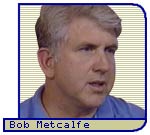 |
|||
 |
|||
![]() Computer Communication
Compatibility
Computer Communication
Compatibility
At about the same time the Alto was appearing on office desks at PARC, Bob Metcalfe finished his Ph.D. thesis at Harvard and was hired by Bob Taylor in 1973. Metcalfe's thesis work was an efficiency study of the ARPAnet and the ALOHAnet, but he had never seen the ALOHAnet work firsthand. So, one of the stipulations of his accepting the job was a three-month visit to Hawaii before he reported to work. In Hawaii, he studied the ALOHAnet in more detail and came back to the mainland with a notebook full of data and ideas for improving the network.
 Norm Abramson, the builder of
ALOHAnet,
created a protocol looser than
that used on
ARPAnet, something similar
to a party line on a telephone.
Because there were no isolated network lines, everyone had to share
the same pathway. Sometimes two or more network packets would be sent
at the same time and none of them would arrive at their target locations
uncorrupted. To correct for this problem, the receiving computer would
check for errors in each packet and would only send back an acknowledgment
if it received a good packet. If the sending computer didn't get an
acknowledgment, it would wait a random amount of time and then send
it again.
Norm Abramson, the builder of
ALOHAnet,
created a protocol looser than
that used on
ARPAnet, something similar
to a party line on a telephone.
Because there were no isolated network lines, everyone had to share
the same pathway. Sometimes two or more network packets would be sent
at the same time and none of them would arrive at their target locations
uncorrupted. To correct for this problem, the receiving computer would
check for errors in each packet and would only send back an acknowledgment
if it received a good packet. If the sending computer didn't get an
acknowledgment, it would wait a random amount of time and then send
it again.
Bob Metcalfe had some ideas for a better protocol. Instead of just sending out a packet, the transmitter would first listen for any traffic and only send it out if no other computers were sending packets. It's similar to the way polite people talk in a group. Instead of interrupting other people, they wait until there's an pause in the conversation. The protocol was called CSMA/CD, which stands for Carrier Sense, Multiple Access with Collision Detection. That just means multiple computers could connect to a single cable and would try to have only polite conversations.
At PARC, Metcalfe worked with Thacker, Lampson (the two inventors of
the Alto), and David Boggs on building a computer card for the Altos.
 Their two test machines were named Michelson and Morley, after the
two early 20th century physicists who disproved the popular belief
that an invisible "ether" filled the universe.
Their two test machines were named Michelson and Morley, after the
two early 20th century physicists who disproved the popular belief
that an invisible "ether" filled the universe.
After several months of building and testing, Metcalfe's team successfully networked the two Altos together. They needed a name for the network protocol, so they continued the ether joke and named it "ethernet." Soon more Altos were connected to the ethernet and then different computers were added, creating a local internet inside PARC.
Although Metcalfe had a useful product, at that time PARC didn't have an easy mechanism to move it to production and to market. He decided that he would produce and market ethernet himself. He was not a businessman, but he was a researcher, so he decided to research the process of building a successful business and then do it. Using the Directory of Western Venture Capitalists he scheduled breakfast, lunch, and dinner meetings with anyone willing to talk to him. To start, he wasn't looking for venture capital, but advice and information.
After nearly a year, while perfecting his product, he found backers and opened his new company. For a name he combined three words that described his business: Computer Communication Compatibility, or 3Com for short.
Copyright © 1998, PBS Online,
Inc. All Rights Reserved.
Site Designed and Developed by
OPB Learning Media